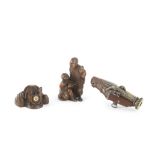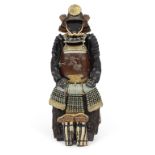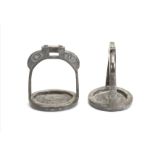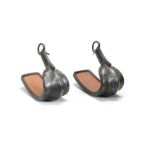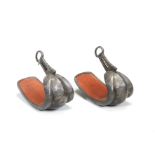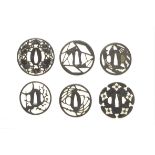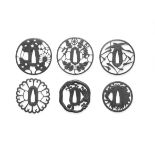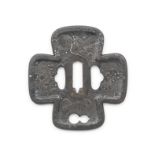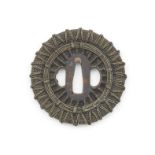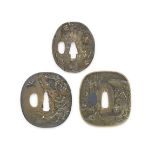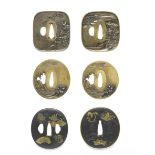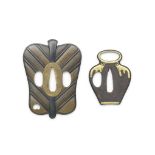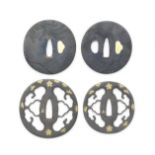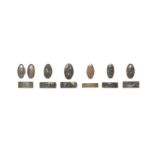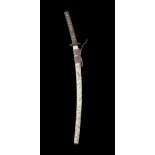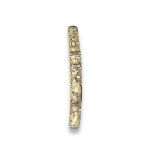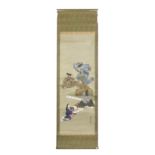Refine your search
Filtered by:
- Category,
- Creator / Brand
- List
- Grid
A subscription to the Price Guide is required to view results for auctions ten days or older. Click here for more information
Three various netsukeEdo period (1615-1868), late 18th/early 19th centuryComprising: a wood samurai kabuto, of typical form, the tehen (finial) an...
A composite armourEdo period (1615-1868), 19th centuryThe helmet and do mounted in the style of the Unkai school, the 32-plate suji kabuto in russ...
A pair of inlaid iron stirrups Probably Korean, Joseon dynasty (1392-1897), 18th/19th century (2)
A pair of inlaid iron stirrupsProbably Korean, Joseon dynasty (1392-1897), 18th/19th centuryEach stirrup decorated all around the sides and edges ...
A pair of inlaid iron abumi (stirrups) Inlaid by Yazaemon Nagatsugu of Kanazawa, Edo period (161...
A pair of inlaid iron abumi (stirrups)Inlaid by Yazaemon Nagatsugu of Kanazawa, Edo period (1615-1868), 18th centuryOf typical form, each inlaid o...
A pair of inlaid iron abumi (stirrups) By Nobukuni, Edo period (1615-1868), late 18th/early 19th ...
A pair of inlaid iron abumi (stirrups)By Nobukuni, Edo period (1615-1868), late 18th/early 19th centuryOf typical form, each inlaid on the front w...
Nine iron sukashi (openwork) tsuba (sword guards) Edo period (1615-1868), 17th to 19th century (18)
Nine iron sukashi (openwork) tsuba (sword guards)Edo period (1615-1868), 17th to 19th centuryUnsigned and circular except as noted, the designs as...
Nine iron sukashi (openwork) tsuba (sword guards) Edo period (1615-1868), 17th to 19th century (18)
Nine iron sukashi (openwork) tsuba (sword guards)Edo period (1615-1868), 17th to 19th centuryUnsigned and circular except as noted, the designs as...
A kyo-shoami iron tsuba (sword guard)Edo period (1615-1868), 17th centuryFour-lobed cruciform with hammered-up rim, the well-patinated iron surfac...
A 'shingen' tsuba (sword guard)Edo period (1615-1868), late 17th/18th centuryCircular, the thick iron plate with elaborate bands of ropework in br...
Three sentoku (brass alloy) tsuba (sword guards)Edo period (1615-1868), 19th centuryThe first irregular oval, chased and inlaid in relief with Soj...
Four tsuba (sword guards)Edo period (1615-1868), 18th/19th centuryThe first iron, almost circular, chased in relief and inlaid in silver with a wi...
Six tsuba (sword guards)Edo period (1615-1868), late 18th/19th centuryUnsigned except as noted: The first two sentoku or brass, of similar design,...
Two unusually shaped tsuba (sword guards)Edo period (1615-1868), late 18th/19th centuryBoth unsigned, the first copper alloy, in the form of a gun...
Two daisho (large and small) sets of tsuba (sword guards) Edo period (1615-1868), 19th century (6)
Two daisho (large and small) sets of tsuba (sword guards)Edo period (1615-1868), 19th centuryThe first set shakudo migaki-ji, each chased in katag...
A set of fuchi (hilt collar), kashira (hilt pommel), and kojiri (scabbard tip), and five fuchi-ga...
A set of fuchi (hilt collar), kashira (hilt pommel), and kojiri (scabbard tip), and five fuchi-gashira (matching hilt collars and pommels)Edo peri...
A koshira-e (set of mounts) for a katana (long sword) The fittings: Edo period (1615-1868), 17th ...
A koshira-e (set of mounts) for a katana (long sword)The fittings: Edo period (1615-1868), 17th to 18th centuryThe saya of polished same, the iron...
A gold-lacquer and Shibayama-inlaid tanto koshira-e (ornamental mounting for a short sword) Meiji...
A gold-lacquer and Shibayama-inlaid tanto koshira-e (ornamental mounting for a short sword)Meiji era (1868-1912), late 19th/early 20th centuryThe ...
Kawanabe Kyosui (1868-1935)Meiji era (1868-1912), late 19th/early 20th centuryScene from The Storehouse of Loyal Retainers; a kakejiku (hanging sc...

